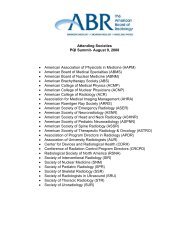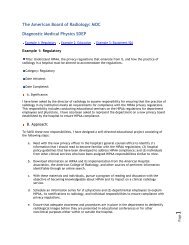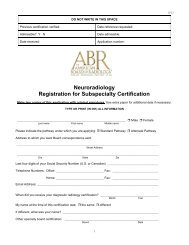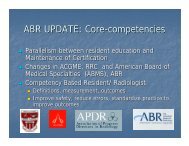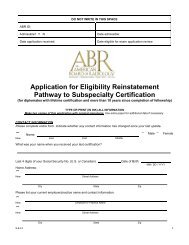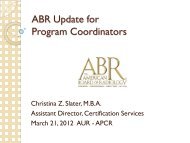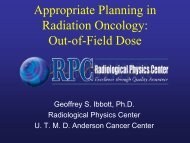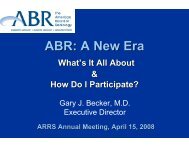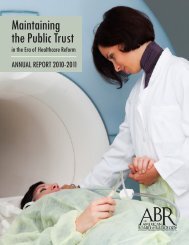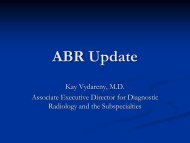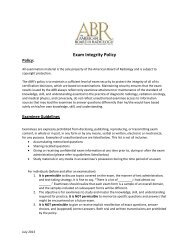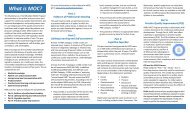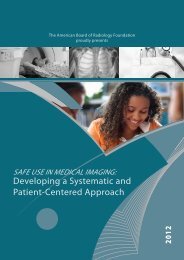MOC for Medical Physics - The American Board of Radiology
MOC for Medical Physics - The American Board of Radiology
MOC for Medical Physics - The American Board of Radiology
Create successful ePaper yourself
Turn your PDF publications into a flip-book with our unique Google optimized e-Paper software.
What is <strong>MOC</strong><br />
<strong>The</strong> Maintenance <strong>of</strong> Certification (<strong>MOC</strong>) program<br />
demonstrates to the public, your peers, and colleagues<br />
your support <strong>for</strong> continuous quality improvement,<br />
pr<strong>of</strong>essional development, and quality patient<br />
care. It is an integral part <strong>of</strong> the quality movement<br />
in healthcare and is highly valued by patients and<br />
physician colleagues alike. <strong>MOC</strong> builds on the validity<br />
<strong>of</strong> the initial certification process and provides a<br />
framework <strong>for</strong> self-regulation by the pr<strong>of</strong>ession to<br />
improve quality <strong>of</strong> care. <strong>The</strong> program embraces the<br />
adult learning principles <strong>of</strong> accumulated life experience,<br />
self-direction, goal-orientation, achievability,<br />
and respect <strong>for</strong> diplomates’ achievements.<br />
<strong>MOC</strong> encompasses the essential competencies<br />
involved in delivery <strong>of</strong> quality care, which extend beyond<br />
medical knowledge. <strong>The</strong> <strong>MOC</strong> program must be<br />
developed and maintained throughout your pr<strong>of</strong>essional<br />
career. It is designed to evaluate, on a continuous<br />
basis, the six essential competencies (initially<br />
developed in residency training) by means <strong>of</strong> four<br />
parts. <strong>The</strong> six competencies are:<br />
• <strong>Medical</strong> knowledge<br />
• Patient care and procedural skills<br />
• Interpersonal and communication skills<br />
• Pr<strong>of</strong>essionalism<br />
• Practice-based learning and improvement<br />
• Systems-based practice<br />
<strong>MOC</strong> uses four parts to evaluate the six competencies:<br />
• Part 1: Evidence <strong>of</strong> pr<strong>of</strong>essional standing<br />
• Part 2: Lifelong learning and self-assessment<br />
• Part 3: Cognitive expertise<br />
• Part 4: Practice quality improvement<br />
For more in<strong>for</strong>mation on the evidence <strong>for</strong> <strong>MOC</strong>, see<br />
the ABMS <strong>MOC</strong> Evidence Library at http://www.<br />
abms.org/EvidenceLibrary.<br />
Part 1:<br />
Evidence <strong>of</strong> Pr<strong>of</strong>essional Standing<br />
This part requires valid, unrestricted licensure to practice<br />
medical physics in all states requiring licensure<br />
<strong>of</strong> medical physicists (FL, HI, NY, TX). Any state board<br />
action against a license must be reported by the diplomate<br />
to the board within 60 days.<br />
If not licensed, letters <strong>of</strong> attestation from an ABRcertified<br />
medical physicist and an ABR-certified<br />
radiologist or radiation oncologist are required. <strong>The</strong><br />
requested statements will attest to the diplomate’s<br />
active involvement in the discipline <strong>of</strong> medical physics,<br />
with specific emphasis on the six areas <strong>of</strong> competency.<br />
Forms to provide guidance and to assist in the<br />
attestation process are available on myABR (https://<br />
myabr.theabr.org)<br />
Part 2:<br />
Lifelong Learning and Self-assessment<br />
At least 75 continuing education (CE) credits are required<br />
every 3 years. CE credits may be met by a combination<br />
<strong>of</strong> Category 1 credits (CAMPEP or ACCME)<br />
and self-directed educational projects (SDEPs).<br />
At least 25 <strong>of</strong> the 75 CE credits must be self-assessment<br />
CE (SA-CE). Other than ABR prequalified SAMs<br />
and SDEPs, the ABR will count all AMA Category 1<br />
CME activities in “enduring materials” (including webbased<br />
and print) and “journal-based CME” <strong>for</strong>mats<br />
toward the <strong>MOC</strong> self-assessment requirement. According<br />
to the recently adopted AMA policy <strong>for</strong> CME,<br />
these activities include the following features that<br />
suit them <strong>for</strong> use as self-assessment tools:<br />
• <strong>The</strong>y provide an assessment <strong>of</strong> the learner that<br />
measures achievement <strong>of</strong> the educational purpose<br />
and/or objective(s) <strong>of</strong> the activity with an established<br />
minimum per<strong>for</strong>mance level; examples include,<br />
but are not limited to, patient-management<br />
case studies, a post-test, and/or the application <strong>of</strong><br />
new concepts in response to simulated problems.<br />
• <strong>The</strong>y communicate to the participants the minimum<br />
per<strong>for</strong>mance level that must be demonstrated in the<br />
assessment to successfully complete the<br />
activity <strong>for</strong> AMA PRA Category 1 Credit.<br />
• <strong>The</strong>y provide a reference to appropriate bibliographic<br />
sources to allow <strong>for</strong> further study.<br />
A maximum <strong>of</strong> one SDEP may be recorded yearly<br />
and can count toward either CE or SA-CE. Fifteen<br />
CE credits are given <strong>for</strong> each completed SDEP, and<br />
project samples can be found on the ABR website.<br />
<strong>The</strong> approach to each project is prospective and must<br />
be defined in advance. <strong>The</strong> components <strong>of</strong> the SDEP<br />
include:<br />
Significance: a statement <strong>of</strong> educational need<br />
Approaches/resources to be utilized: a list <strong>of</strong> activities<br />
designated to address the need<br />
Evaluation: documentation <strong>of</strong> achievement<br />
Impact on practice: outcome statement<br />
For more in<strong>for</strong>mation on Part 2 requirements, go to<br />
http://www.theabr.org/moc-rp-comp2.<br />
Part 3:<br />
Cognitive Expertise<br />
This part requires having passed the <strong>MOC</strong> exam<br />
within the past 10 years. <strong>The</strong> exam will be proctored,<br />
secure, and computer-based. Approximately 30<br />
percent <strong>of</strong> the material on the examination is core<br />
diagnostic, nuclear, or therapeutic (dependent on certificate)<br />
medical physics, technology, and safety. <strong>The</strong><br />
rest is taken from recent advances in each respective<br />
field. <strong>The</strong> exam <strong>for</strong> the maintenance <strong>of</strong> any certificate<br />
in medical physics is <strong>of</strong>fered one time each year. An<br />
exam must be taken in each discipline in which the<br />
diplomate is maintaining certification.<br />
Diplomates may take the exam any time it is <strong>of</strong>fered<br />
during the <strong>MOC</strong> process, including multiple times<br />
if necessary. Study guides have been prepared and<br />
posted on the ABR website <strong>for</strong> each medical physics<br />
certificate area and are meant to help with preparing<br />
<strong>for</strong> the exam. <strong>The</strong> guides are not all inclusive, but<br />
indicate the general topics that will be included on<br />
each respective exam.<br />
Part 4:<br />
Practice Quality Improvement (PQI)<br />
<strong>The</strong> analysis and improvement <strong>of</strong> medical physics<br />
practice is an important aspect <strong>of</strong> the activities <strong>of</strong><br />
medical physicists. Through Part 4, <strong>MOC</strong> also <strong>of</strong>fers<br />
a pathway <strong>for</strong> participation in practice quality improvement<br />
(PQI). <strong>The</strong> PQI initiative is a framework<br />
to facilitate improvement <strong>of</strong> medical care and/or its<br />
delivery <strong>for</strong> an individual, a group, or an institution.<br />
Quality and safety in medical care have become a<br />
national priority, and Part 4 <strong>of</strong> <strong>MOC</strong> permits medical<br />
physicists to demonstrate both their commitment to<br />
this enterprise and, in some instances, their compliance<br />
with associated external requirements.<br />
<strong>The</strong> diplomate will engage in one PQI project every<br />
3 years. Sample PQI projects <strong>for</strong> each <strong>of</strong> the three<br />
sections <strong>of</strong> medical physics are posted on the ABR<br />
website. <strong>The</strong> ABR will review and qualify national programs<br />
developed by pr<strong>of</strong>essional societies <strong>for</strong> fulfillment<br />
<strong>of</strong> the criteria <strong>of</strong> Part 4. In addition, diplomates<br />
can <strong>for</strong>mulate and execute specific PQI projects <strong>of</strong><br />
their own design that would satisfy the PQI requirements<br />
in achieving continuous quality improvement<br />
within individual practice.<br />
Projects can be developed by individuals, group<br />
practices, hospitals, institutions, or societies. <strong>The</strong> five<br />
areas <strong>for</strong> PQI project choices are:<br />
• Patient safety<br />
• Accuracy <strong>of</strong> interpretation and calculations<br />
• Report turnaround times<br />
• Practice guidelines and standards<br />
• Surveys
How do I participate<br />
Continuous Certification<br />
<strong>The</strong> ABR has implemented a new integrated process<br />
that links the ongoing validity <strong>of</strong> certificates to meeting<br />
the requirements <strong>of</strong> Maintenance <strong>of</strong> Certification<br />
(<strong>MOC</strong>). Under the new process, known as “continuous<br />
certification,” ABR certificates will no longer have<br />
“valid-through” dates. Instead, on each new certificate<br />
in diagnostic radiology, radiation oncology, or medical<br />
physics, the date <strong>of</strong> initial certification will be noted and<br />
accompanied by the statement that “ongoing validity <strong>of</strong><br />
this certificate is contingent upon meeting the requirements<br />
<strong>of</strong> Maintenance <strong>of</strong> Certification.”<br />
For each diplomate who is a current enrollee in <strong>MOC</strong>,<br />
continuous certification has replaced the 10-year <strong>MOC</strong><br />
cycle.<br />
Under the new policy, implemented in 2012, the total<br />
number <strong>of</strong> <strong>MOC</strong> requirements will not change. Progress<br />
will be evaluated annually in March, using a rolling<br />
calendar-year “look-back.” <strong>The</strong> first “full” annual<br />
look-back, including <strong>MOC</strong> Parts 1-4 and fees, will occur in<br />
March 2016.<br />
How does Continuous Certification work<br />
<strong>MOC</strong><br />
Year<br />
Lookback<br />
date<br />
Element(s) checked<br />
2012 3/15/2013 Licensure or Pr<strong>of</strong>essional Standing<br />
Attestation/Exam<br />
2013 3/15/2014 Licensure or Pr<strong>of</strong>essional Standing<br />
Attestation/Exam<br />
2014 3/15/2015 Licensure or Pr<strong>of</strong>essional Standing<br />
Attestation/Exam<br />
2015 3/15/2016 Licensure or Pr<strong>of</strong>essional Standing<br />
Attestation, CE/SA-CE, Exam, PQI,<br />
and Fees<br />
2016 3/15/2017 Licensure or Pr<strong>of</strong>essional Standing<br />
Attestation, CE/SA-CE, Exam, PQI,<br />
and Fees<br />
2017 3/15/2018 Licensure or Pr<strong>of</strong>essional Standing<br />
Attestation, CE/SA-CE, Exam, PQI,<br />
and Fees<br />
2018 3/15/2019 Licensure or Pr<strong>of</strong>essional Standing<br />
Attestation, CE/SA-CE, Exam, PQI,<br />
and Fees<br />
20XX 3/15/20XX Licensure or Pr<strong>of</strong>essional Standing<br />
Attestation, CE/SA-CE, Exam, PQI,<br />
and Fees<br />
Useful Links<br />
<strong>The</strong> <strong>American</strong> <strong>Board</strong> <strong>of</strong> <strong>Radiology</strong><br />
www.theabr.org<br />
CME Gateway<br />
www.cmegateway.org<br />
ABMS Public Website<br />
www.certificationmatters.org<br />
myABR<br />
https://myabr.theabr.org<br />
Maintenance <strong>of</strong><br />
Certification<br />
(<strong>MOC</strong>)<br />
What It Is and<br />
What It Means <strong>for</strong> You<br />
For <strong>Medical</strong> Physicists<br />
Please note that the ABR will conduct yearly,<br />
random audits. If you are audited, you will be asked<br />
to submit documentation <strong>of</strong> your current progress<br />
on <strong>MOC</strong> Parts 1, 2, and 4.<br />
Status Check <strong>for</strong> “Meeting Requirements”<br />
Element Compliance Requirement<br />
Licensure At least 1 valid license or pr<strong>of</strong>essional<br />
standing attestation in previous 5 years<br />
CE<br />
At least 75 Category 1 CE credits in previous<br />
3 years<br />
<strong>The</strong> <strong>American</strong> <strong>Board</strong> <strong>of</strong> <strong>Radiology</strong> is a Member<br />
<strong>Board</strong> <strong>of</strong> the <strong>American</strong> <strong>Board</strong> <strong>of</strong> <strong>Medical</strong><br />
Specialties (ABMS):<br />
www.abms.org<br />
<strong>MOC</strong> Evidence Library:<br />
www.abms.org/EvidenceLibrary<br />
SA-CE<br />
At least 25 <strong>of</strong> the 75 CE credits in previous<br />
3 years must be Self-Assessment CE<br />
(SA-CE).<br />
Exam<br />
Passed ABR Initial Certification or <strong>MOC</strong><br />
exam in previous 10 years<br />
PQI<br />
Fees<br />
Completed at least 1 PQI project in previous<br />
3 years<br />
Current with <strong>MOC</strong> fees at any time during<br />
the previous 3 years<br />
5441 E. Williams Circle, Tucson, AZ 85711-7412<br />
520-519-2152 • Fax: 520-790-3200<br />
abrmocp@theabr.org<br />
05/13



